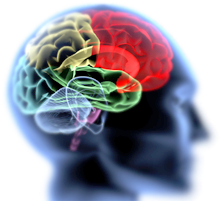The Anatomy of the Brain
 The brain is an amazing and complex organ in our body. It is our body’s computer, processing our thoughts, emotions, and actions. Even the slightest damage to the brain can cause our personality to change, our physical reactions to slow, and our emotions to be off balance. So what exactly does the brain consist of? The folks over at traumaticbraininjuryatoz.org offer an excellent synopsis of the anatomy of the brain that is worth reposting here:
The brain is an amazing and complex organ in our body. It is our body’s computer, processing our thoughts, emotions, and actions. Even the slightest damage to the brain can cause our personality to change, our physical reactions to slow, and our emotions to be off balance. So what exactly does the brain consist of? The folks over at traumaticbraininjuryatoz.org offer an excellent synopsis of the anatomy of the brain that is worth reposting here:
A healthy adult brain weighs about 2 and a half to 3 pounds, and is located inside the skull, which protects the brain from injury.
Inside the skull, the brain is covered by three thin protective layers called the meninges. The space between the meninges and the brain is filled with a clear liquid called cerebral spinal fluid. This fluid works to keep the central nervous system healthy.
The brain is constantly sending and receiving signals from all over the body. The body then uses these signals to do things like think, move, talk, see, and understand. These signals also control our personalities and the way we behave. Each part of the brain has a specific job and links with other parts of the brain to do more difficult tasks.
The most basic functions of the brain, such as breathing, are controlled at the deepest level, called the brain stem. Further up in the brain, more complicated functions, such as emotions are controlled. At the highest levels, the most complex functions such as reasoning are found.
The outermost and largest part of the brain is called the cerebrum and it controls things like thoughts and actions. It has a wrinkled surface and is divided it into two halves, known as the left and right hemispheres.
Each hemisphere of the cerebrum is divided into four sections, called lobes. These lobes are known as the frontal lobe, the parietal lobe, the occipital lobe, and the temporal lobe.
Beneath the cerebrum is the limbic system, sometimes referred to as the “emotional brain.” This part of the brain is involved with human emotions and memories. Underneath the limbic system, located at the base of the brain, is the brain stem which is responsible for maintaining the body’s most basic functions such as breathing, heartbeat, and blood pressure.
Located at the back of the brain beneath the occipital lobes, is the cerebellum. Like the cerebrum, the cerebellum is divided into two halves, called hemispheres. The main job of the cerebellum is to control, regulate and coordinate movement, posture, and balance.
Because of its complex nature, people who have suffered brain injuries who also may have the possibility of bringing a lawsuit because of how the brain injury began need attorneys who not only understand the legal process, but who have experience and understanding of the brain and what happens when people suffer brain injuries. The attorneys at the Manchin Injury Law Group focus on traumatic brain injury litigation and can help you through this difficult time. If you or a loved one has suffered a traumatic brain injury because of someone’s carelessness, call the Manchin Injury Law Group at 304-367-1862 to schedule a free consultation.
